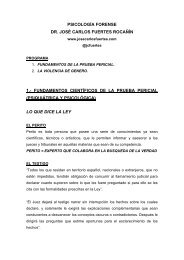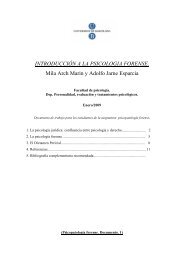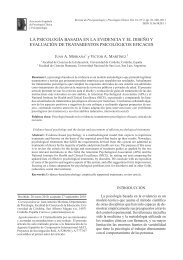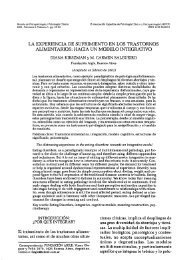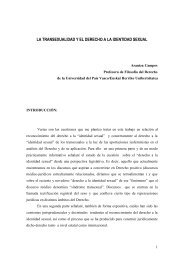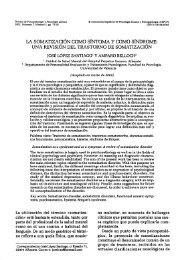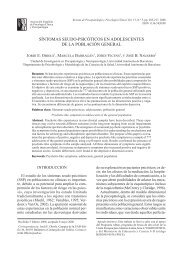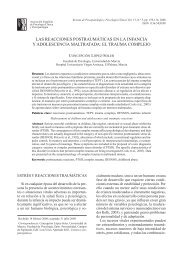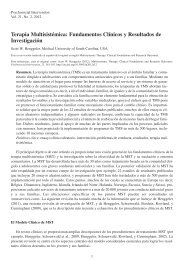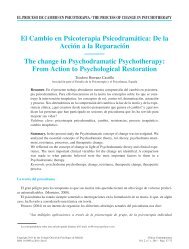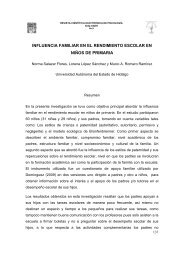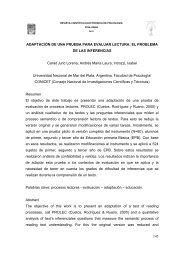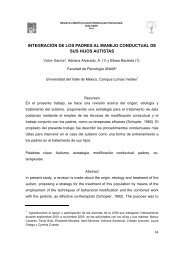aq7n6gr
aq7n6gr
aq7n6gr
You also want an ePaper? Increase the reach of your titles
YUMPU automatically turns print PDFs into web optimized ePapers that Google loves.
194 ACTIVACIÓN CONDUCTUAL EN UN CASO DE DEPRESIÓN<br />
lishes with the environment from a certain time<br />
onward. Depression is thus conceived as a whole situation<br />
in which one is immersed, and not only as a<br />
dysphoric emotional state. Its characteristic symptoms<br />
(for example, negative ideation, anhedonia,<br />
loss of energy, attention and concentration, social<br />
isolation, abandonment, changes in eating or sleeping,<br />
etc.) are conceived as behaviors that perpetuate<br />
this situation. Logically, from this point of view,<br />
cognitive deficit or neurochemicals are not relevant,<br />
nor does the term “disease” make sense, but rather<br />
the exact opposite. “The sense” that behaviors have<br />
is emphasized to find relief (as the means of escape<br />
that they are), although in the long term they<br />
become unadapted and provoke more and more suffering.<br />
Today, BA has acquired broad evidence for its efficacy,<br />
both in well-controlled experimental works<br />
(Dimidjian et al., 2006; Gawrysiak, Nicholas, &<br />
Hopko, 2009), and in case studies (Bottonari,<br />
Roberts, Thomas, & Read, 2008; Hopko, Lejuez, &<br />
Hopko, 2004; Hopko, Robertson, & Lejuez, 2006;<br />
Santiago-Rivera, Kanter, Benson, Derose, Illes, &<br />
Reyes, 2007), such as the one described in this article.<br />
The subject treated was a 44-year-old male with<br />
severe symptoms of depression and anxiety. He<br />
came for consultation a few weeks after having separated<br />
from his wife. This separation was motivated<br />
by the patient’s infidelity, and took place in a very<br />
tense atmosphere. The case was evaluated by means<br />
of several self-reports (BDI-II, ATQ, AAQ, STAI,<br />
EROS and BADS), by an unstructured clinical interview<br />
and self-records (although these were only<br />
partly answered). The evaluation took five weeks.<br />
The most notable symptoms in the beginning were<br />
profound sadness, despondency and desperation,<br />
and, associated with them, a wide set of cognitive,<br />
social and personal problems among which were<br />
marked alteration of sleep (in particular, difficulty<br />
falling asleep and doing so late, nightmares and<br />
unrefreshing sleep), appetite (the subject lost ten<br />
kilograms), negative ideation and self-guilt (ideas<br />
about death, of leading a life without sense, of having<br />
failed in everything important, of having some<br />
mental defect or damage, etc.) and of being incapable<br />
of maintaining his work commitments and the<br />
activity which he was carrying out at that time.<br />
Clínica y Salud<br />
Vol. 21, n.° 2, 2010 - Págs. 183-197<br />
The information acquired established the basal<br />
mood state, as well as the type and level of his activity<br />
and also abandoned activities. Through a detailed<br />
examination of his behavioral dynamics and<br />
of associated feelings, a functional analysis was formulated<br />
which revealed how many of the activities<br />
he carried out had an escape/avoidance function.<br />
The BA model turned out to be coherent in explaining<br />
why in reality the subject was so depressed,<br />
although his work was intense and varied (lectures,<br />
courses, permanent collaboration with media, etc.),<br />
which in principle should have translated into a<br />
higher mood state. In fact, all the patients work was<br />
at the service of avoidance, since that way he was<br />
not in contact with the reality of his family loss, did<br />
not confront other tasks which were more important<br />
to him according to his values, and the sense that he<br />
had wanted to imprint on his life (that is, be a writer<br />
and write a new book) and did not relate with friends<br />
or any possible future partner. The model also made<br />
sense of his main symptoms, since the sleep affection,<br />
which wrecked his schedules, his bad health,<br />
ruminating negative thoughts and the vivid memory<br />
of his past happy life now lost, “impeded” him from<br />
making vital changes, so they became maintainers<br />
of his current state.<br />
Treatment of the case, which took seven months<br />
(in 22 sessions), began with a detailed explanation of<br />
the intervention model and the functional analysis,<br />
which justified the process to be followed.<br />
According to the logic described, we decided to activate<br />
certain behavior connected to the patient’s values<br />
and likely to provide long-term positive reinforcement,<br />
as well as extinguish others, which,<br />
although reinforcing in the short term, were no more<br />
than forms of avoidance. Thus, more specifically, we<br />
agreed on progressive activation of: (1) Keeping<br />
fixed schedules (for going to bed, getting up and<br />
working); (2) Starting to write his latest book again<br />
and keeping this activity up (first for an hour a day<br />
at least, and later up to five hours); (3) Being with<br />
his children at least once a week and alternating<br />
weekends assigned to him; and (4) Getting in touch<br />
with groups of friends and acquaintances on alternating<br />
weekends (when he was not supposed to be with<br />
his children). And extinction or progressive moderation<br />
of the following behavior: (1) Participating in<br />
Copyright 2010 by the Colegio Oficial de Psicólogos de Madrid<br />
ISSN: 1130-5274 - DOI: 10.5093/cl2010v21n2a7




